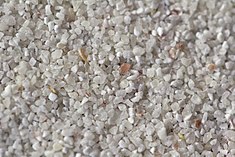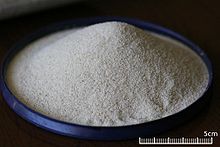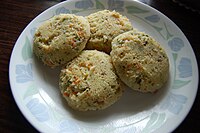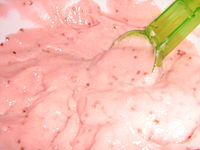Semolina
 Semolina grains in close-up | |
| Nutritional value per 100 g (3.5 oz) | |
|---|---|
| Energy | 1,506 kJ (360 kcal) |
72.83 g | |
| Dietary fiber | 3.9 g |
1.05 g | |
| Saturated | 0.15 g |
| Monounsaturated | 0.124 g |
| Polyunsaturated | 0.43 g |
12.68 g | |
| Vitamins | Quantity %DV† |
| Vitamin A equiv. | 0% 0 μg |
| Thiamine (B1) | 24% 0.28 mg |
| Riboflavin (B2) | 7% 0.08 mg |
| Niacin (B3) | 22% 3.31 mg |
| Vitamin B6 | 8% 0.1 mg |
| Folate (B9) | 18% 72 μg |
| Vitamin B12 | 0% 0 μg |
| Vitamin C | 0% 0 mg |
| Minerals | Quantity %DV† |
| Calcium | 2% 17 mg |
| Iron | 9% 1.23 mg |
| Magnesium | 13% 47 mg |
| Phosphorus | 19% 136 mg |
| Potassium | 4% 186 mg |
| Sodium | 0% 1 mg |
| Zinc | 11% 1.05 mg |
| Other constituents | Quantity |
| Water | 12.67 g |
| |
| †Percentages are roughly approximated using US recommendations for adults. Source: USDA FoodData Central | |
Semolina is the coarse, purified wheat middlings (intermediate milling stage) of durum wheat mainly used in making couscous, pasta, and sweet puddings.[1] The term semolina is also used to designate coarse middlings from other varieties of wheat, and sometimes other grains (such as rice or corn) as well.
Etymology[]
Semolina is derived from the Italian word semolino.[2] 1790–1800; alteration of Italian semolino, equivalent to semol(a) "bran" (Latin simila "flour") + -ino diminutive suffix. It is a milled flour of durum wheat (or other hard wheat) used mainly in pasta. In the Lithuanian language sumalta means something that is milled, miltai means "flour" and malti means "to mill", while semolina in Lithuanian language is manai.[citation needed] The words simila, semidalis, groat, and grain may all have similar proto-Indo-European origins as two Sanskrit terms for wheat, samita and godhuma, or may be loan words from the Semitic root smd "to grind into groats" (cf. Arabic: سميد samīd).[3]
Production[]

Modern milling of wheat into flour is a process that employs grooved steel rollers. The rollers are adjusted so that the space between them is slightly narrower than the width of the wheat kernels. As the wheat is fed into the mill, the rollers flake off the bran and germ while the starch (or endosperm) is cracked into coarse pieces in the process. Through sifting, these endosperm particles, the semolina, are separated from the bran. The semolina is then ground into flour. This greatly simplifies the process of separating the endosperm from the bran and germ, as well as making it possible to separate the endosperm into different grades because the inner part of the endosperm tends to break down into smaller pieces than the outer part. Different grades of flour can thus be produced.[4]
Types[]
Semolina made from hard durum wheat (Triticum turgidum subsp. durum) is pale yellow in color.[5] It may be milled either coarse or fine, and both are used in a wide variety of sweet and savory dishes, including many types of pasta. Common names in other languages include:
- Italian: semola di grano duro; coarse (no descriptor), fine rimacinata
- Greek: simigdáli σιμιγδάλι; coarse chondró χονδρό, fine psiló ψιλό
- Arabic: samīd سميد; coarse ḵašin خشن, fine nāʿim ناعم
- Turkish: irmik; coarse iri, fine ince
- Hindi: baṃsī ravā, bansi rava बंसी रवा (milled only coarse, not fine)
Semolina made from softer common wheat (Triticum aestivum) is beige in color; it contains more gluten and is less sandy in its texture than durum semolina. In the United States, it is called farina (not to be confused with Italian farina, which is common-wheat flour); it is used more often for desserts than for salty foods. In India, common-wheat semolina may be milled either coarse or fine, and both are used in a wide variety of sweet and savory dishes. Common names in other languages include:
- Hindi: sūjī, sooji सूजी, or ravā रवा; coarse moṭī मोटी, fine bārīk बारीक
Broadly speaking, meal produced from grains other than wheat may also be referred to as semolina, e.g., rice semolina and corn semolina. Corn semolina is commonly called grits in the United States.
Dishes[]
Savory[]
In Germany, Austria, Hungary, Bosnia, Bulgaria, Serbia, Slovenia, Romania, Slovakia and Croatia, (durum) semolina is known as (Hartweizen-)Grieß (a word related to "grits") and is mixed with egg to make Grießknödel, which can be added to soup. The particles are fairly coarse, between 0.25 and 0.75 millimeters in diameter. It is also cooked in milk and sprinkled with chocolate to be eaten as breakfast.
In Italy, (durum) semolina is used to make a type of soup by directly boiling fine semolina in vegetable or chicken broth. Semolina can also be used for making a type of gnocchi called Gnocchi alla Romana, where semolina is mixed with milk, cheese and butter to form a log, then cut in discs and baked with cheese and bechamel.

Semolina is a common food in West Africa, especially among Nigerians. It is eaten as either lunch or dinner with stew or soup. It is prepared just like eba (cassava flour) or fufu with water and boiled for 5 to 10 minutes.
In much of North Africa, durum semolina is made into the staple couscous.
In Pakistan and North India semolina is called sooji, and in South India,rava. Semolina is used to make savory South Indian foods, like rava dosa, rava idli, rava kitchadi and upma. It is used to coat slices of fish before it is pan-fried in oil.
Sweet[]
In the US, semolina (specifically farina) is boiled to produce a porridge; a popular brand of this is Cream of Wheat.


In e.g. Austria, Germany, Hungary, Bosnia, Bulgaria, Slovenia, Serbia, Romania, Croatia, Slovakia and the Czech Republic (common wheat) semolina (Weichweizengrieß in German) is cooked with milk and sugar. In English this kind of dessert is commonly known as semolina pudding (in German as Grießbrei).
A baked dish containing semolina called migliaccio is present in the Neapolitan tradition in Italy; it is a mixture of ricotta, vanilla and citrus peel, similar to the filling in sfogliatelle, with added semolina flour to obtain a simple, firm cake.
In Slovakia, Sweden, Estonia, Finland, Lithuania, Latvia, Poland, Romania, Ukraine, Belarus, Israel, and Russia, it is eaten as a breakfast porridge, sometimes mixed with raisins and served with milk. In Swedish it is known as mannagrynsgröt, or boiled together with blueberries, as blåbärsgröt. In Sweden, Estonia, Finland, and Latvia, for a dessert usually eaten in summer, semolina is boiled together with juice from berries and then whipped into a light, airy consistency to create klappgröt (Swedish name), also known as vispipuuro (Finnish name) or mannavaht (Estonian name) or debessmanna (Latvian name).
In the Middle East and North Africa, basbousa (also called harisa in some varieties of Arabic, e.g. Alexandrian dialect of Egyptian Arabic) is a sweet semolina cake soaked in fragrant syrup and frequently topped with nuts. In North Africa, it is also used to make harcha, a kind of griddle cake often eaten for breakfast, commonly with jam or honey.[6]
In Indian sub continent, semolina (called Rava, suji or shuji) is used for such sweets as halwa and rava kesari. Such a preparation is also a popular dessert in Greece (halvas) and Cyprus (halvas). In Greece, the dessert galaktoboureko is made by making a custard from the semolina and then wrapping it in phyllo sheets. In Cyprus, the semolina may be mixed also with almond cordial to create a light, water-based pudding. In Turkey (helva), Bulgaria (halva), Iran (halva), Pakistan (halva), Bangladesh (halua), Palestine (khalva), and Arab countries, halawa is sometimes made with semolina scorched with sugar, butter, milk, and pine nuts. In Nepal, semolina is called suji and is used for preparing sweet dishes like haluwa (Nepali equivalent of Indian and Pakistani halwa) or puwa. In Myanmar (Burma), semolina (called shwegyi) is used in a popular dessert called sanwin makin. In Sri Lanka semolina is called rulan and used to make creamy porridge and a sweet confectionery called "rulan aluwa".In Turkey a sweet dish called Shakker Parey is made with Semolina and white flour.
In baking[]
As an alternative to corn meal, semolina can be used to flour the baking surface to prevent sticking. In bread making, a small proportion of durum semolina added to the usual mix of flour is said to produce a tasty crust.[citation needed]
See also[]
References[]
- ^ "Semolina - Definition". Merriam-Webster. Retrieved 2017-04-01.
- ^ "Home : Oxford English Dictionary". www.oed.com. Retrieved August 25, 2019.
- ^ Company, Houghton Mifflin Harcourt Publishing. "The American Heritage Dictionary entry: semolina". www.ahdictionary.com. Retrieved August 25, 2019.
- ^ Wayne Gisslen (2001), Professional Baking, John Wiley & Sons
- ^ "Semolina Flour". Spiritfoods. Archived from the original on 6 September 2012. Retrieved 21 September 2012.
- ^ Anthony Ham; Paula Hardy; Alison Bing; Lonely Planet Publications (2007). Morocco. Lonely Planet. p. 74. ISBN 978-1-74059-974-0.
External links[]
 Media related to Semolina and wheat farina at Wikimedia Commons
Media related to Semolina and wheat farina at Wikimedia Commons
- Breakfast cereals
- Cereals
- Wheat
- Algerian cuisine
- Arab cuisine
- Egyptian cuisine
- Greek cuisine
- Iraqi cuisine
- Israeli cuisine
- Jordanian cuisine
- Lebanese cuisine
- Levantine cuisine
- Libyan cuisine
- Moroccan cuisine
- Pakistani cuisine
- Palestinian cuisine
- Syrian cuisine
- Tunisian cuisine
- Ukrainian cuisine
